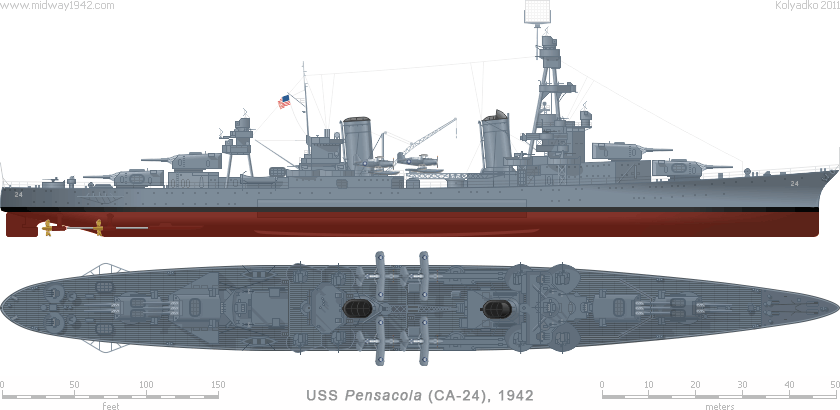
| Pensacola class | HEAVY CRUISERS | |

| Displacement: | 11,512 t (9,100 t Std) | Machinery: | 8 boilers, 4 shafts | Main Guns: | 10×8 in (203 mm)/55 | Main Belt: | 4-2.5 in | 102-63.5 mm | |||||||||
|---|---|---|---|---|---|---|---|---|---|---|---|---|---|---|---|---|---|
| Max Length: | 585 ft 6 in | 178.46 m | Max Power: | 107,750 hp | 79 250 kW | DP Guns: | 8×1×5 in (127 mm)/25 | Decks: | 1.75-1 in | 44.5-25 mm | |||||||
| Beam: | 65 ft 3 in | 19.89 m | Max Speed: | 32 kts | 59.26 km/h | AA Guns: | 4×4×1.1 in (28 mm)* | Barbettes: | 0.75 in | 19 mm | |||||||
| Draght: | 19 ft 6 in | 5.94 m | Range: | 10,000 nm | 18 520 km | AA Guns: | 8×1×.79 in (20 mm)* | Turrets: | 2.5-.75 in | 63.5-19 mm | |||||||
| Complement: | 653 officers & enlisted | Bunkerage: | 3,952 t fuel oil | Aircraft: | 4 × SOC-1 Seagull | CTower: | 1.25 in | 32 mm | |||||||||
* Antiaircraft armament as during the Battle of Midway (June 1942).
Two Pensacola class heavy cruisers were the first U.S. “treaty cruisers”, designed under the limitations set by the Washington Naval Treaty, which limited the displacement of cruisers to 10,000 tons, and its main battery caliber to 8 in (203 mm). Flush-decked and with their main battery equally divided fore and aft, they were handsome and well-proportioned ships, but in an effort to remain within treaty limits the hull was of welded construction, and the armor belt was barely capable of withstanding even 5 in (127 mm) gunfire.
Their main armament consisted of ten 8 in guns, in two twin turrets on the main deck, and two triple turrets two decks above, making it one of the two U.S. Navy ship classes to have different-sized turrets for the main armament. The new 8 in gun cruisers brought a new capability to the fleet when they entered the service. They replaced the elderly fast battleships of the Scouting Force and served not merely as scouts but, perhaps much more importantly, as escorts for the new fast carriers in independent task force operations.
The Pensacolas were initially armed also with four 5 in (127 mm) double purpose guns, eight .50 in (12.7 mm) AA machine guns, and six 21 in (533 mm) torpedo tubes. But before World War II began, the torpedo tubes were removed due to wargaming results from the Naval War College which indicated that the torpedoes were unlikely to be fired from a cruiser, and more a liability than an asset. At the same time, the anti-aircraft armament was increased with four additional 5 in (127 mm) guns and four of the four-barrel 1.1 in (28 mm) autocannons.
One Pensacola class heavy cruiser (CA-24 Pensacola) took part in the Battle of Midway as a part of Task Force 16 Cruiser Group (Task Group 16.2).
| Ship | Builder | Laid Down | Launched | Commisioned | Fate | |||||||||||||
|---|---|---|---|---|---|---|---|---|---|---|---|---|---|---|---|---|---|---|
| CA-24 | Pensacola | U. S. Navy Yard. New York, NY | 27 | Oct | 1926 | 25 | Apr | 1929 | 6 | Feb | 1930 | Sunk as target | 10 | Nov | 1948 | |||
| CA-25 | Salt Lake Sity | New York Shipbuilding, NJ | 9 | Jun | 1927 | 23 | Jan | 1929 | 11 | Dec | 1929 | Sunk as target | 25 | May | 1948 | |||